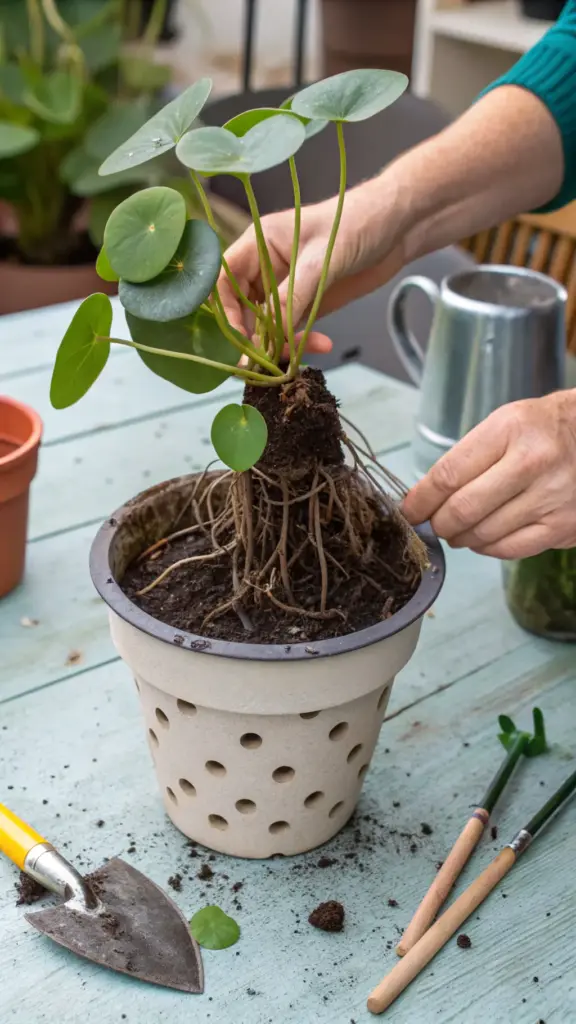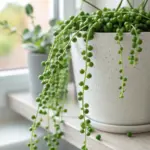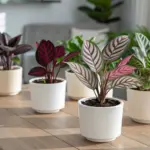6. They Know When and How to Repot Properly

I used to repot my Chinese money plants whenever I felt like giving them a “fresh start.” Spoiler alert: that’s not how it works at all!
My poor plants would go into shock for weeks after my well-intentioned repotting sessions. I was basically traumatizing them every time I thought I was helping.
Learning the nursery approach to repotting timing completely changed my success rate. Now my plants actually thank me instead of sulking for a month!
Clear Signs It’s Actually Time to Repot
Roots growing out of drainage holes is the most obvious sign, but I wait for more evidence before making the move. One or two roots poking out isn’t enough.
I gently lift my plant out of its pot once a year to check the root situation. If roots are circling around the bottom in tight spirals, it’s definitely time.
The plant stops growing despite good care – that’s my biggest red flag. When everything else is perfect but growth stalls, it’s usually a root-bound issue.
Water running straight through the pot without being absorbed means there’s no soil left, just roots. Time for an upgrade!
Choosing the Right Pot Size and Material
Here’s where I used to mess up big time: going from a 4-inch pot straight to an 8-inch pot. One size up only – that’s the golden rule I wish I’d known earlier.
Too much extra soil around the roots stays wet too long and causes root rot. I learned this after killing a perfectly healthy plant with “kindness.”
Terracotta pots are absolutely the best choice for Chinese money plants. They breathe and help prevent overwatering mistakes like mine.
Plastic pots work too, but you need to be way more careful with watering. I prefer terracotta because it’s more forgiving of my occasional heavy-handed watering.
Root Pruning Techniques That Actually Help
Root pruning sounds scary, but it’s actually really beneficial for older Chinese money plants. I was terrified the first time, but my plant loved it.
I trim away any black, mushy, or circling roots with clean scissors. Healthy roots are white or light tan – anything darker gets the chop.
If the root ball is super tight, I gently tease apart the outer roots with my fingers. This encourages them to grow outward instead of continuing to circle.
I never remove more than 1/3 of the root system at once. That’s too much stress for the plant to handle.
Timing Repotting with Growth Cycles
Spring is absolutely the best time for repotting Chinese money plants. They’re just waking up from winter dormancy and ready to grow into their new space.
I avoid repotting during winter when the plants are basically hibernating. Disturbing dormant plants just stresses them out for no good reason.
Late summer repotting can work, but the plant needs time to establish before winter hits. I prefer to wait until the following spring if it’s past July.
Never repot a plant that’s already stressed from pests, disease, or recent changes. Wait until it’s healthy and stable.
My Repotting Day Process
I prepare everything before touching the plant – new pot, fresh soil mix, clean tools. Having everything ready makes the process faster and less stressful.
I water the plant lightly a day before repotting so the soil holds together but isn’t soggy. Bone dry soil falls apart and damages roots during removal.
I gently squeeze the sides of the old pot to loosen the root ball before trying to remove the plant. No yanking on stems!
Fresh soil goes in the bottom, plant goes in, then I fill around the sides while gently tapping to settle everything.
Post-Repotting Care That Prevents Shock
No fertilizer for at least 6-8 weeks after repotting! The fresh soil has plenty of nutrients, and fertilizer can burn damaged roots.
I place newly repotted plants in slightly lower light for the first week or two. They need to focus energy on root recovery, not photosynthesis.
Watering gets tricky after repotting because the new soil holds moisture differently. I check daily but water less frequently until the plant establishes.
I resist the urge to check if it’s “working” by tugging on the plant. Leave it alone to do its thing!
My Biggest Repotting Disaster
I once repotted three plants on the same day using old, compacted potting soil from a bag that had been sitting in my garage. All three plants struggled for months.
Fresh, quality potting mix is worth every penny when repotting. Cheap or old soil doesn’t drain properly and can harbor fungus.
Now I always buy new soil for repotting day, even if I have some leftover from last year. It’s plant insurance.
The Recovery Timeline Reality Check
Most Chinese money plants take 2-4 weeks to fully recover from repotting. Some leaf dropping is normal – don’t panic!
New growth is the best sign that repotting was successful. Once I see fresh leaves emerging, I know the roots are happy in their new home.
I keep a little journal noting repotting dates so I don’t forget when I last did it. These plants only need repotting every 2-3 years if you choose the right size pot.
Conclusion
These six professional strategies can transform your Chinese money plant from surviving to absolutely thriving! The difference between amateur plant care and nursery-level expertise often comes down to these detailed techniques that most gardening blogs never mention.
Start with just one or two of these methods – maybe upgrading your soil mix or adjusting your watering routine. You’ll be amazed at how quickly your Pilea responds to professional-level care! Your plant corner will soon rival those gorgeous home decor photos you’ve been admiring on Pinterest.
Ready to become the plant parent your Chinese money plant deserves? Pick one technique from this list and try it this week. Your future self (and your thriving plants) will thank you!









GIPHY App Key not set. Please check settings